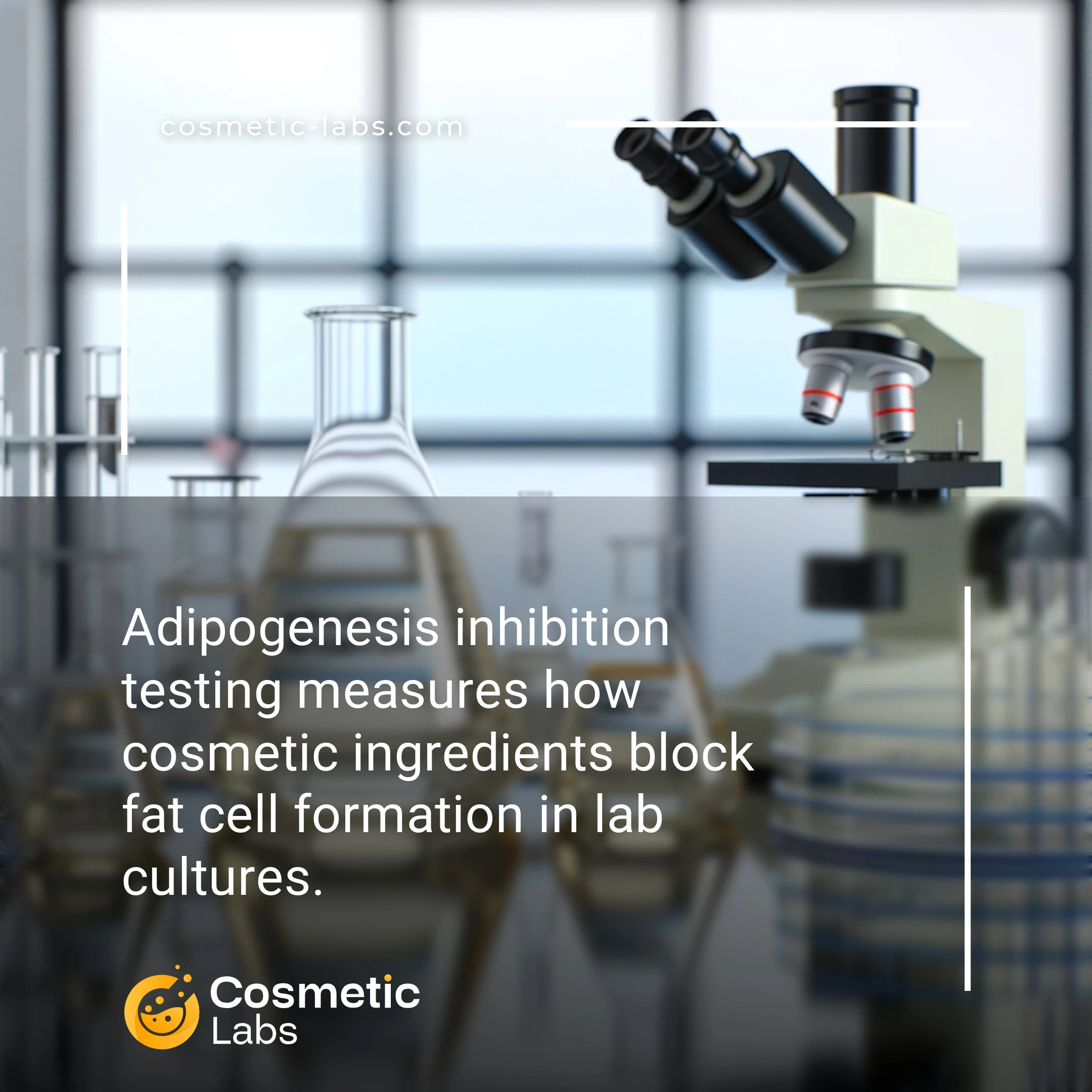Adipogenesis Inhibition Testing for Slimming Cosmetics

What is Adipogenesis inhibition?
Adipogenesis inhibition testing services measure how effectively cosmetic ingredients prevent fat cell formation and differentiation in laboratory conditions. Our partner labs use 3T3-L1 preadipocyte cell cultures to evaluate active compounds’ ability to block lipid accumulation and reduce adipocyte maturation. These preclinical assays provide quantitative data on ingredient efficacy before clinical trials, helping brands validate slimming claims with scientific evidence that regulatory bodies accept.
Why do you need this service?
Cosmetic labs perform adipogenesis inhibition testing to validate anti-cellulite creams and body contouring serums before market launch. Teams measure fat cell differentiation rates using 3T3-L1 preadipocyte assays, providing brands with quantifiable efficacy data for regulatory submissions and marketing claims. This preclinical testing helps you avoid costly reformulations by identifying the most effective active concentrations early in development.
Who provides Adipogenesis inhibition services?
All cosmetic labs providing Adipogenesis inhibition services
There is no company providing these services at the moment.
Adipogenesis Inhibition Testing for Slimming Products
Adipogenesis inhibition testing validates your slimming product’s ability to prevent fat cell formation and reduce lipid accumulation. Our partner labs use advanced cell culture models and molecular analysis to measure how effectively your formulations block the differentiation of preadipocytes into mature fat cells.
Cell-Based Assay Protocols
Labs run standardized 3T3-L1 preadipocyte assays to test your active ingredients and finished formulations. These protocols measure lipid droplet formation and track key adipogenic markers like PPARγ and C/EBPα expression levels.
Testing typically includes:
- Dose-response curves for ingredient concentration optimization
- Oil Red O staining for lipid quantification
- Gene expression analysis via qPCR
- Cytotoxicity screening to establish safe concentration ranges
Molecular Pathway Analysis
Advanced testing examines how your ingredients interfere with adipogenic signaling pathways. Labs analyze protein expression changes and measure metabolic markers to understand your product’s mechanism of action.
Key measurements include transcription factor activity, enzyme inhibition studies, and glucose uptake assays. Results help you optimize formulations and support regulatory claims with solid scientific data.
Connect with specialized labs on our platform to discuss your adipogenesis inhibition testing requirements and timeline.
Practical Applications of Adipogenesis Inhibition Testing for Slimming Products
Cosmetic labs use adipogenesis inhibition testing for slimming formulations to validate anti-fat claims and support product positioning in competitive beauty markets.
Body Contouring Cream Development
Beauty brands developing topical slimming products rely on adipogenesis inhibition assays to demonstrate their formulations can prevent fat cell formation. Labs expose 3T3-L1 preadipocytes to test ingredients like caffeine, forskolin, or botanical extracts, measuring differentiation markers after 7-14 days.
This testing validates claims for targeted fat reduction in problem areas like thighs, abdomen, and arms. Results show percentage inhibition of lipid accumulation compared to controls, providing concrete data for marketing materials and regulatory submissions.
Active Ingredient Screening Programs
Raw material suppliers and formulators use adipogenesis inhibition screens to identify promising compounds for slimming applications. Labs test multiple concentrations of plant extracts, peptides, or synthetic molecules against standardized protocols.
These screenings reveal dose-response relationships and help rank ingredient efficacy. Companies can prioritize the most active compounds for further development, reducing formulation costs and accelerating time-to-market for new slimming products.
| Testing Parameter | Measurement Method | Typical Results |
|---|---|---|
| Lipid Accumulation | Oil Red O Staining | 20-80% inhibition |
| Cell Viability | MTT Assay | >85% viable cells |
| Differentiation Markers | qPCR Analysis | 2-10 fold reduction |
| Testing Duration | Protocol Timeline | 10-14 days |
Ready to validate your slimming formulation’s efficacy? Contact specialized cosmetic labs on our platform to discuss adipogenesis inhibition testing protocols tailored to your product development needs.
